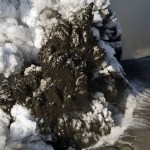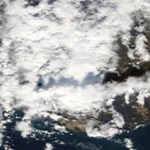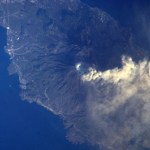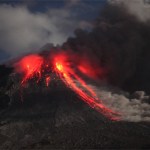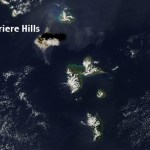ash plumes
Guatemala's Santa Maria volcano with the dome complex visible in the foreground.
I got a tip the other day from an Eruptions reader of something afoot at Guatemala's Santiaguito - a part of the larger Santa Maria volcano - and sure enough, there are reports today that the volcano is experiencing an "unusual and violent" display. The articles I can find only mention that ash was spread over six provinces in the western part of the country, which is unusual for this volcano that normally produces diffuse ash plumes and minor dome collapse avalanches (at least in the recent past). The Institute…
Night image of Eyjafjallajökull erupting on April 24, 2010. Image courtesy of James Ashworth.
A quick update on the Eyjafjallajökull eruption: Not a lot to report in terms of changes in the volcanic activity at the volcano. The update from the Icelandic Met Office last night sums it up nicely:
Overall activity similar as yesterday. Eruption seen from west in the morning - north crater still active. External water has not affected vent activity much since 18 April. Geologists' field observations (2-10 km from vents) show that explosivity is magmatic and that the tephra produced since 18…
A night shot of the Eyjafjallajökull eruption showing the glowing plume from the strombolian explosions and the Aurora Borealis overhead.
A quick update on the current activity at Eyjafjallajökull eruption: the eruption continues at the summit craters, but there seems to be less ash being erupted, at least yesterday. The latest update from the Icelandic Met Office suggest that things are settling down - but floods are still periodically being produced by melting of the glacier:
Volcanic tremor has been similar the last 24 hours. GPS stations around Eyjafjallajökull showed deflation…
A strombolian eruption in the crater of Eyjafjallajökull, taken on April 19, 2010. Image courtesy of the Icelandic Met Office.
The Eyjafjallajökull eruption in Iceland has been one of the most fascinating eruptions in recent memory - and this is beyond the fact that it is a prime example of a "wired" eruption, where people from around the world can follow every aspect of the eruption from the comfort of their home. What will really be interesting is the political fallout from the six day closure of the airspace over most of Europe due to the ash. If you read the press, you'd think that…
The ash-and-steam plume from Eyjafjallajökull on April 19, 2010.
Eyjafjallajökull in Iceland is slowly settling into a pattern of strombolian-to-surtseyan (depending on meltwater access to the crater) explosions that have been sending ash up to 2-5 km above the summit. We can see this new, more diffuse plume in the recent NASA EO image of the eruption taken April 19. There is still abundant ice to melt at the summit as there have been a number of floods overnight and this morning near the volcano, betraying the continuing production of meltwater by the eruption. The Icelandic Met office…
Gaua erupting in February 2010. Image courtesy of the NASA Earth Observatory.
As a certain famous Icelandic native would say, "there is more to life than this."
Some other volcano news from around the world:
The situation at Gaua in Vanuatu is worsening. Ash from the current eruption is contaminating water and food supplies on the island. Authorities are planning on evacuating 3,000 people from the island if the eruption that started in 2009 gets worse, but there has already been significant ash fall, mudflows and explosions.
Shiveluch on the Kamchatka Peninsula in eastern Russia continues…
Eyjafjallajokull erupting on 4/17/2010, image by Marco Fulle. Note the "rooster tails" of ash and steam, typical for Surtseyan eruptions.
European airspace has slowly begun to reopen as the explosive eruptions at Eyjafjallajökull have become less intense over the last 24 hours. However, there is still lots of hazardous airspace and airports around places like London and across the UK remain closed - leaving people stranded. We will still have to wait to see what the political ramification are, especially after EU officials claim "flaws" in their decision and the over $1 billion losses by…
National Geographic film crew near Eyjafjallajökull, April 18, 2010.
UPDATE 1PM EDT 4/19/2010: I can almost categorically say that Hekla is NOT erupting, contrary to Twitter or the brief banner on MSNBC. See my comment below (#68).
In what is sounding like a bit of a broken record, the eruption at Eyjafjallajökull is still going. However, we might be beginning to see some changes in the style of volcanism - even the first suggestion of lava flows at the new crater. As mentioned yesterday, since the eruption became subglacial, we've been seeing eruptions where water - in this case glacial…
Some very quick notes on Eyjafjallajökull:
Eyjafjallajökull erupting at night on April 17/18, 2010, with impressive incandescent explosions.
European airlines are taking "test flights" to see the effect of the ash on their aircraft in hopes to convince EU officials to reopen airspace. Now, officials from KLM say that everything went fine in their test flight, but I haven't seen any details about flightplans, altitude and all the sorts of info you'd want to see if you want to believe these test flights are representative. However, the president of KLM does have a bit of a point in saying…
The eruptive plume from Eyjafjallajökull taken Holsvelli webcam. Image courtesy of Mattias Larsson.
Sorry to disappoint everyone visiting to blog while they sit at any number of airports around the world, but the eruption at Eyjafjallajökull appears to still be going strong. The Icelandic Met Office is heading up to the volcano to conduct a survey of the crater area to find out (1) what it looks like and (2) how much new water (i.e., ice) is there available for the erupting magma. More water is likely to mean more explosive eruptions in this phreatoplinian style - however, like I…
The ash plume from the 2010 Eyjafjallajökull eruption.
To say that the Eyjafjallajökull eruption has become the most significant volcano-related news story of the year would be an understatement. There has been wall-to-wall coverage on every major media outlet, dissecting everything from the effect of ash on jets, to the effect of ash on people, to wildly premature commentary on the climatic effect of the eruption to the potential place in history of this event. The eruption is affecting a wide swath through society: the European economy may take a hit of billions of dollars due to…
The ash from the Eyjafjallajökull eruption as it spreads over Europe on April 15, 2010.
The newly-subglacial Eyjafjallajökull eruption of 2010 has now begun to be felt outside of Iceland. The ash being thrown into the atmosphere from this explosive phase of the eruption has prompted officials in the United Kingdom, Ireland and Norway to close the airspace above their nations due to the threat that ash poses to jet aircraft. Remember, the silica glass shards that make up most ash can melt inside jet engines, causing them to stall - which could lead to crashing. Luckily, so far we have not…
The steam and ash plume from the Eyjafjallajökull subglacial eruption that started early morning, April 14, 2010.
Well, after the brief respite when there was speculation Eyjafjallajökull-Fimmvörduháls eruption might be over, we now know what was going on. After the original fissures ceased activity, the magma found a new route to the surface, this time underneath the Eyjafjallajökull glacier. Eruptions readers last night watched as an earthquake swarm arrived underneath the icecap, which prompted Icelandic officials to start evacuating people from the area around the volcano (photo…
The steam-and-ash plume from Eyjafjallajokull in Iceland, March 22, 2010.
Overnight, the Eyjafjallajokull eruption in Iceland added to its oeuvre, producing what is being reported to be a 8-km plume. Images of the plume (above) suggest (to me) that it is very water-rich, so likely this is the expanding(?) fissure interacting with snow, ice or groundwater, producing steam explosions. These explosions have some minor ash component to them, mostly from the shattering of rapidly cooled lava, but are dominated by steam.
The eruption appears to be continuing into its third day unabated. Flights…
Catching up with some news:
Anatahan erupting in the northern Mariana Islands in 2003.
I ran across this article right before I got sick, but its been popping up around the interwebs (and is pretty interesting). It details a study in Molecular Ecology that suggests that populations of caribou in Canada's Yukon Territory were strongly effected by the White River Tephra. The White River Tephra is supposedly the largest Holocene plinian tephra (from a ash cloud fallout), with two components dating from ~1900 years ago and ~1250 years ago. The vent for the WRT is likely from a vent beneath the…
The flu has retreated and I'm getting back on track. Huzzah!
I'll get back to the blog by posting this week's new USGS / Smithsonian Institution Global Volcanism Program Weekly Volcano Report. Looks like some interesting stuff in it ...
Looks like there were some small eruptions from Oldoinyo Lengai in Tanzania. The volcano is one of the few (only active?) carbonatite volcanoes in the world, erupting a lava composed primarily of calcium carbonate and sodium minerals with very little silica. It leads to the odd lava that erupt black (and cool ~ 500C) and cool to white, making it one of the…
Sakurajima Volcano in Japan, taken from the ISS on February 17. Image courtesy of Soichi Noguchi.
Eruptions reader Tim Stone sent me a link to the TwitPic feed for Soichi Noguchi, the Japanese astronaut currently on board of the International Space Station. The space traveller got a shot of Sakurajima from space, showing a beautiful plume drifting off - and great detail of the towns and roads near the volcano. Soichi has some other great shots (and comments to go with them), including my old haunt Seattle (with a comment about Ichiro), Mt. Aso - another Japanese volcano, and the Patagonian…
Not a lot of big news, but a lot of little news:
Soufriere Hills at night during the late January 2010 dome growth episode. Note the hot rock falls from the collapsing dome. Image courtesy of Photovolcanica.
This might not be new, but Dr. Boris Behncke brought the new webcam at the rim of Chaiten in Chile to my attention. You get a birds-eye view of the growing dome from the edge of the caldera - pretty nifty view for a once-in-a-hundred-years sort of event.
The NASA Earth Observatory has posted a close-up of the Soufriere Hills imagethat I posted yesterday, showing the February 11 plume.…
A couple bits of news:
The ash plume from the February 11, 2010 eruption of Soufriere Hills taken by theAqua MODIS camera. Image courtesy of the NASA Earth Observatory.
Flights have been disrupted in the West Indies since last week with the large dome-collapse eruptions of Soufriere Hills on Montserrat. The 10 km / ~35,000 foot ash plume is apparently lingering in the air at commercial flight levels, meaning delays, cancellations or long detours for many flights in the area. Flights in and out of Dominica, Guadelope, Montserrat, Anguilla, St. Kitts and Nevis have all been effected by the…
Two impressive eruptions going on right now:
Soufriere Hills erupting on February 11, 2010. Image courtesy of the Montserrat Volcano Observatory.
Soufriere Hills just keeps on raising the bar during its new eruptive period. The volcano on Montserrat in the West Indies produced a 15 km / ~45 000 foot ash plume as the summit dome partially collapsed again. It was one of the biggest volcanic events at Soufriere Hills in the last 15 years, with 10-15% of the dome collapsing. One of the regional airlines in the West Indies have had to cancel flights due to the ash that has mainly been heading to…
